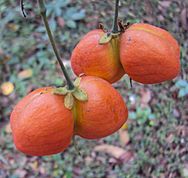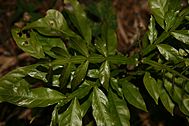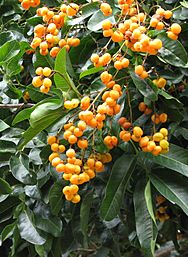Harpullia facts for kids
Quick facts for kids Harpullia |
|
|---|---|
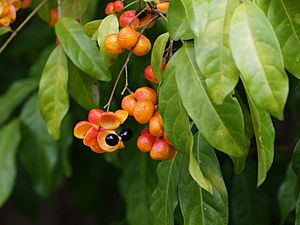 |
|
| Harpullia pendula: fruits, seeds and foliage (above), habit (below) |
|
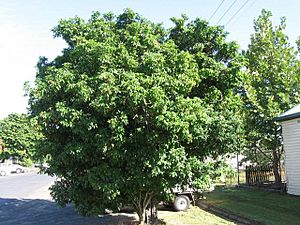 |
|
| Scientific classification |
|
| Kingdom: | Plantae |
| Clade: | Tracheophytes |
| Clade: | Angiosperms |
| Clade: | Eudicots |
| Clade: | Rosids |
| Order: | Sapindales |
| Family: | Sapindaceae |
| Subfamily: | Dodonaeoideae |
| Genus: | Harpullia Roxb. |
| Type species | |
| Harpullia cupanioides Roxb.
|
|
| Species | |
|
See text |
|
Harpullia is a group of about 27 types of small to medium-sized rainforest trees. They belong to the plant family called Sapindaceae. You can find these trees in many places. They grow from India all the way east through Malesia, Papuasia, and Australasia, reaching the Pacific Islands. They usually live in or near rainforests.
Most of the different Harpullia species, about twenty of them, are found in New Guinea and its nearby islands.
Australia also has some Harpullia species, about eight types. They grow naturally from northeastern New South Wales up through eastern Queensland to Cape York Peninsula and the coast of the Northern Territory. Six of these eight Australian species are found only in Australia. They are often called tulipwoods because their dark wood was very valuable. One type, Harpullia pendula, is often planted as a street tree along Australia's east coast. Another, H. frutescens, is a small bush that could be grown in gardens.
About the Harpullia Trees
The name Harpullia was first written down by European scientists in 1824. This was done by a Scottish botanist named William Roxburgh. The name comes from "Harpulli," which was a local name for the plant in Chittagong, India.
In 2011, a botanist named Wayne Takeuchi found and described a new Harpullia species in New Guinea. It was the first new one found there since 1940!
Scientists have studied Harpullia trees in many ways. They have looked at their shapes, how their leaves are built, and even their pollen. These studies help us understand how the different Harpullia species are related to each other and where they came from. They also study the chemicals found in these plants, especially things called saponins.
Different Types of Harpullia Species
There are many different types of Harpullia trees. Here is a list of some of them. These names come from important plant lists and scientific studies from around the world.
- Harpullia alata F.Muell. – Found only in southeastern Queensland to northeastern New South Wales, Australia.
- Harpullia arborea (Blanco) Radlk., also known as H. pedicellaris Radlk. – Grows in Sri Lanka, India, Assam, Thailand, southern Vietnam, throughout Malesia (including New Guinea), northeastern Australia, and Pacific Islands like Fiji, Vanuatu, Samoa, and Tonga.
- Harpullia austro-caledonica Baill. – Found only in New Caledonia.
- Harpullia camptoneura Radlk. – Grows in northeastern New Guinea.
- Harpullia carrii Leenh. – Found in Papua New Guinea.
- Harpullia cauliflora K.Schum. & Laut. – Grows in New Guinea.
- Harpullia crustacea Radlk. – Found in eastern New Guinea.
- Harpullia cupanioides Roxb., also known as H. thanatophora Blume – Grows in southern China, Assam, Andaman Islands, Bangladesh, Myanmar, Thailand, Indochina, throughout Malesia (including New Guinea), and the Northern Territory of Australia.
- Harpullia frutescens F.M.Bailey – Found only in northeastern Queensland, Australia.
- Harpullia giganteacapsula Vente – Grows in eastern New Guinea.
- Harpullia hillii F.Muell. – Found only from east-central Queensland to northeastern New South Wales, Australia.
- Harpullia hirsuta Radlk. – Grows in southwestern New Guinea.
- Harpullia largifolia Radlk. – Found in New Guinea.
- Harpullia leichhardtii Benth. – Found only on the coastal Northern Territory, Australia.
- Harpullia leptococca Radlk. – Grows in southeastern New Guinea.
- Harpullia longipetala Leenh. – Found in eastern New Guinea.
- Harpullia mabberleyana W.N.Takeuchi – Grows in New Guinea.
- Harpullia myrmecophila Merr. & L.M.Perry – Found in northwestern New Guinea.
- Harpullia oococca Radlk. – Grows in New Guinea.
- Harpullia peekeliana Melch. – Found in New Ireland (New Guinea).
- Harpullia pendula Planch. ex F.Muell. – Grows from northeastern Queensland through eastern Queensland to northeastern New South Wales, Australia.
- Harpullia petiolaris Radlk. – Found in Borneo, the Maluku Islands, and New Guinea.
- Harpullia ramiflora Radlk., also known as H. aeruginosa Radlk. – Grows in the Philippines, Moluccas, New Guinea, and Cape York Peninsula, Australia.
- Harpullia rhachiptera Radlk. – Found in New Guinea.
- Harpullia rhyticarpa C.T.White & W.D.Francis – Found only in northeastern Queensland, Australia.
- Harpullia solomonensis Vente – Grows in the Solomon Islands and Bismarck Archipelago.
- Harpullia vaga Merr. & L.M.Perry – Found in the Solomon Islands and Malesia, including New Guinea.
- Species that used to be in Harpullia but are now in a different group
- Harpullia zanguebarica (J.Kirk.) Radlk. ⇒ Majidea zanguebarica J.Kirk. ex Oliv. – Found in eastern Africa.
See also
 In Spanish: Harpullia para niños
In Spanish: Harpullia para niños


